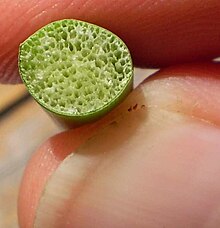
Back نسيج هوائي Arabic Aerènquima Catalan Aerenchym Czech Parenchyma#hym German Aerénquima Spanish Tuuletussolukko Finnish Aérenchyme French Աերենքիմա Armenian Aerenkima ID Aerenkimo IO

Aerenchyma or aeriferous parenchyma [1] or lacunae, is a modification of the parenchyma to form a spongy tissue that creates spaces or air channels in the leaves, stems and roots of some plants, which allows exchange of gases between the shoot and the root.[2] The channels of air-filled cavities (see image to right) provide a low-resistance internal pathway for the exchange of gases such as oxygen, carbon dioxide and ethylene between the plant above the water and the submerged tissues. Aerenchyma is also widespread in aquatic and wetland plants which must grow in hypoxic soils.[3][4]
The word "aerenchyma" is Modern Latin derived from Latin aer for "air" and Greek enkhyma for "infusion."[5]
- ^ Martínez-Girón, Rafael; Pantanowitz, Liron; Martínez-Torre, Cristina (2020). "Plant material (aeriferous parenchyma and sclereid cells) mimicking mucormycosis in sputum cytology". Diagnostic Cytopathology. 48 (12): 1309–1312. doi:10.1002/dc.24474. ISSN 1097-0339. PMID 32445261. S2CID 218860436.
- ^ Sculthorpe, C. D. 1967. The Biology of Aquatic Vascular Plants. Reprinted 1985 Edward Arnold, by London.
- ^ Keddy, P.A. 2010. Wetland Ecology: Principles and Conservation (2nd edition). Cambridge University Press, Cambridge, UK. 497 p
- ^ Kozlowski, T. T. (ed.) 1984. Flooding and Plant Growth. Orlando, FL: Academic Press.
- ^ "parenchyma | Origin and meaning of parenchyma by Online Etymology Dictionary". www.etymonline.com. Retrieved 2021-07-14.
© MMXXIII Rich X Search. We shall prevail. All rights reserved. Rich X Search